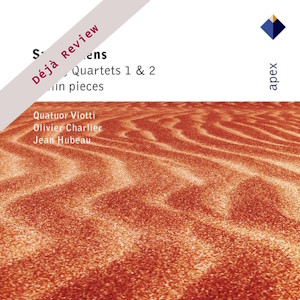
Camille Saint-Saëns (1835-1921)
Sonata for violin and piano No. 1, in D minor, op. 75 (1885)
Sonata for violin and piano No. 2, in E flat major, op. 102 (1896)
Berceuse, op. 38, for violin and piano (1871)
Elegie, op. 160, for violin and piano (1920)
Elegie, op. 143, for violin and piano (1915)
Romance, op. 37, for violin and piano (1871)
String Quartet No. 1 in E minor, op. 112 (1899)
String Quartet No. 2 in G major, op. 153 (1919)
Quatuor Viotti
Olivier Charlier (violin)
Jean Hubeau (piano)
rec. 1984/97, Studios 103 & 107, Radio-France
Apex 2564 614262 [2 CDs: 120]
It is unfortunate that Saint-Saëns is celebrated for only a relatively small part of his prolific output; namely the Tone Poem: Danse macabre, the Symphony No. 3 ‘Organ’ and The Swan, from the Carnival of the Animals. However the music of this multi-talented composer has for a number of years been undergoing a welcome resurgence. Hyperion have been partly responsible for this in the form of their thanks award-winning set of The Complete Works for Piano and Orchestra recorded in 2000-01 by Stephen Hough and the CBSO under Sakari Oramo on CDA67331/2. One only has to hear the two Piano Triosto be aware of the magnificent scores that await general discovery. Thankfully this anthology of previously released material from the Erato label, now available on this super-budget priced Warner Classics Apex disc, will go a long way to assist the composer’s case. In short these chamber works are simply superb and this set is one of my records of the year.
Saint-Saëns wrote his passionate first Violin Sonata in 1885 whilst at the height of his compositional powers, which was around the time of the famous Carnival of the Animals and the celebrated ‘Organ’ Symphony. By the time of the first Violin Sonata he was now a most experienced composer for the violin having written his three Violin Concertos and the celebrated Introduction and Rondo Capriccioso for Violin and Orchestra. This is a fine performance from the admirable team of violinist Olivier Charlier and pianist Jean Hubeau who are most natural and never over-project their expression. I particularly enjoyed their interpretation of the first movement Allegro agitato which for the first time in this work allows me to hear impressionist suggestions.
Composed in 1896 the second Violin Sonata is more classical in approach yet is no less engaging especially in a performance as fine as this. The third movement Andante is especially well performed, long on expression and short on self-indulgence. Overall there is a strong sense of assurance and conviction from the well matched soloists which is both gratifying and admirable.
In spite of the considerable merits of this version from Charlier and Hubeau on Apex the heightened sense of engagement and extra tenderness on the splendid new recording of the first Saint-Saëns Violin Sonata from Sarah Chang and Lars Vogt on EMI Classics 5 57679 2 remains my leading recommendation. The attractive coupling of the Franck and Ravel Violin Sonatas add to the appeal of the EMI Classics release.
Composed over a span of fifty years the four Pieces for Violin and Piano; the Berceuse, the two Elegies and the Romance are wonderful scores that are more than mere miniatures and deserve to be better known in the chamber repertoire. The gifted soloists offer really delightful interpretations of these enchanting and often beautiful scores.
Refined, inventive and of the highest musical calibre the String Quartets No. 1 in E minor and No. 2 in G major are products of the composer’s full maturity. For me they demand repeated plays before completely revealing their manifold rewards to the listener. Composed when Saint-Saëns was aged 65 the four movement String Quartet No. 1 has been described as, ‘a beautifully proportioned work’. My personal highlight is the supremely expressive manner that the magnificent Quatuor Viotti bring to the first movement Allegro which projects a pastoral mood that could have emanated from the pen’s of Howells or Delius. A ‘model of clarity’, the three movement String Quartet No. 2 was one of the composer’s very last compositions. Really striking is the exceptional and charming central movement Molto adagio which I would describe as a true masterpiece. The playing of Quatuor Viotti has great warmth with considerable finesse and refinement throughout.
I remain impressed with the interpretations of the two Saint-Saëns String Quartets by the Medici String Quartet on Koch Schwann 3-6484-2 from 1997. However these two accounts by Quatuor Viotti are now the ones to have for their high calibre of playing and for their masterful penetration into the very heart of the scores.
I found the recorded sound satisfactory demonstrating a bright piano compared to a slightly dry but pleasing violin tone. Concise, interesting and informative annotation.
Simply wonderful chamber works superbly performed. This disc would have been strongly recommended at full-price. An indispensable release.
Michael Cookson
Help us financially by purchasing from



















